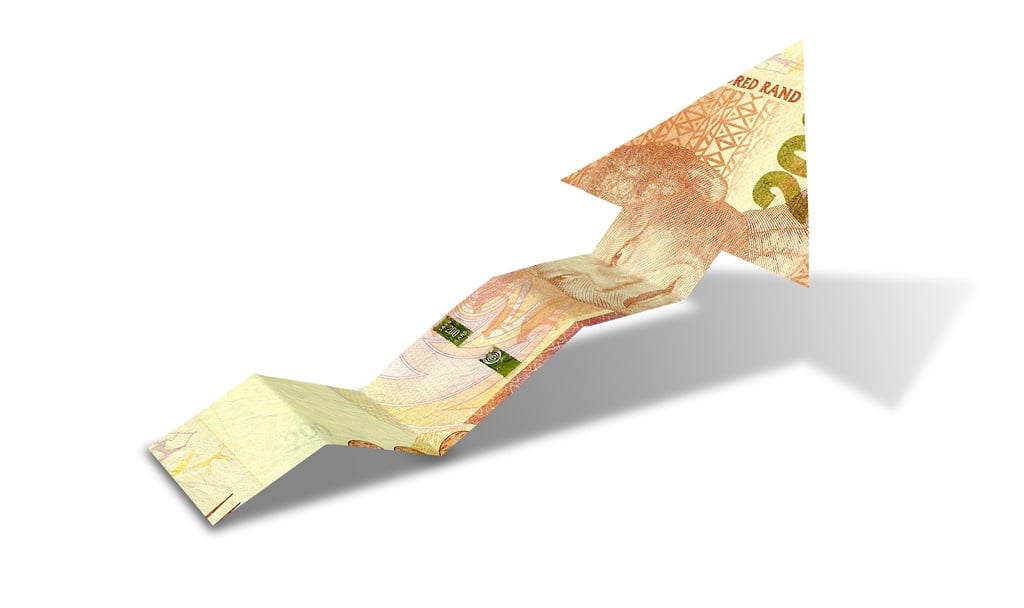

An arrow graph trend shaped R200 bank note. (Getty)
Overall, it cannot be guaranteed that we have reached the top of the interest rate hiking cycle, writes Arthur Kamp.
The
Reserve Bank increased its repo rate by 50bp to 8.25% at the conclusion of its
Monetary Policy Committee (MPC) meeting on Thursday, underlining its inflation
fighting credentials.
At the same time, although consumer inflation is expected
to slow from its current level of 6.8%, the Bank lifted its headline CPI
forecast for a year out in 2Q24 to 5.3% from 5.0% previously. It also signaled
that inflation risk is skewed to the upside.
This leaves the door open for
possible future interest rate hikes.
Two of the
most significant risks to the interest rate outlook are changes in the Rand and
the outcomes of upcoming US FOMC meetings. Recent developments in the currency
market are especially important. Rand depreciation can feed through into
significant so-called second round effects, whereby the initial impact of higher
import prices on inflation is amplified by higher production costs and / or
wage demands.
It is, therefore, concerning that the Bank warns:
Given upside inflation risks, larger domestic and external financing needs, and load-shedding, further currency weakness appears likely.
To be
clear, the Bank responds to the inflationary impact of Rand weakness, rather
than movements in the exchange rate itself. However, the situation is worrying,
especially since loadshedding is driving up the cost of doing business, while
food price inflation is expected to remain high. In this environment, second-round
impacts could be significant.
At the
same time, the US Federal Reserve matters as demonstrated by the tightening of
global financial conditions, which is partly responsible for softer foreign
capital inflows into South Africa. Although stresses in the US banking system
are likely to keep the US FOMC on hold when it meets in June 2023, the ongoing
tightness of the US labour market and the relative stickiness of US core CPI
may lead to another US interest rate hike in July 2023.
South
Africa has not fared well against this backdrop. In the end, as illustrated
this month, the fundamental underlying problem is a balance of payments
constraint. Net foreign capital inflows, deterred by low prospective returns,
policy uncertainty and a lack of infrastructure have been insufficient to fund the
current account deficit. This implies macroeconomic policy must be tightened.
South Africa’s pressing socio-economic problems and the failure of specific
state-owned companies have precluded aggressive fiscal policy tightening.
Hence, the onus has been on the Reserve Bank to do the heavy lifting.
Overall,
it cannot be guaranteed that we have reached the top of the interest rate
hiking cycle. Much will depend on developments in the Rand and its potential
inflation implications, while the Bank is also keen to see elevated inflation
expectations moderate.
Even so,
despite the risks, this may still be the case. The currency has depreciated a
long way, while the interest rate hiking cycle is far advanced. At some point
this is likely to have the desired effect. As 2023 wears on the focus may shift
from interest rate worries to economic growth worries.
Also,
historically, the interest rate hiking cycle has typically ended once it is
clear inflation has peaked and is heading decisively towards the intended
target. On current information, we think we are approaching that point.
Arthur Kamp, Chief Economist at Sanlam Investments. News24 encourages freedom of speech and the expression of diverse views. The views of columnists published on News24 are therefore their own and do not necessarily represent the views of News24.